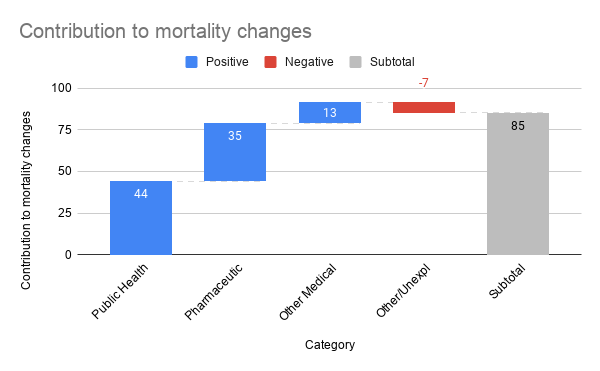What is the impact of pharmaceuticals on US life expectancy?
A paper by Buxbaum et al. (2020) examines changes in life expectancy in the U.S. and finds that life expectancy increased by 2.5 years between 1990 and 2015. These data on mortality came from the Centers for Disease Control and Prevention Wide-ranging Online Data for Epidemiologic Research (CDC WONDER) database.
More interesting is that the authors examine the sources of these changes in life expectancy comparing the impact of public health, pharmaceuticals, medical care and an “other” category. A cause-deletion methodology was employed by the authors to measure the relative contribution of the various categories considered.
The authors find that public health contributes 44% of the life expectancy gains while pharmaceuticals contribute 35%, other medical 13% and other -7%.

It is important to take into consideration, however, that life expectancy depends not just on medical illnesses but also other factors such as trauma (e.g., motor vehicle accident, homicide). If the analyses was limited only to medical causes of death, pharmaceutical impacts would be much higher (as a relative share of the mortality impact). Further, while pharmaceuticals contributes only 5% of life expectancy improvement from deaths due to “malignant neoplasms of trachea, bronchus, lung” immediately after this period immuno-oncology treatments were developed which revolutionized lung cancer care. In short, the pharmaceutical impact on life expectancy may be even higher if recent years were included.
It also appears that pharmaceutical spending gave a fairly high value for the money spent. Let’s do a quick back of the envelope calculation. US national health expenditures increased from $0.7 billion to $3.2 billion between 1990 and 2015, and pharmaceutical expenditures increased by $0.3 billion. In other words, 11% of the increase in health care expenditures was due to pharmaceuticals. However, from the Buxbaum article we saw that 35% of life expectancy gains were due to pharmaceuticals. Consider another way of looking at this: cost per person on pharmaceuticals increased by $1000 per person over this time frame based on CMS national health expenditure data). However, gaining about a year of life expectancy is almost certainly worth that additional cost. While more rigorous analyses are needed, based on this back of the envelope calculation, it looks like pharmaceutical spending may give more bang for the buck than other forms of medical care.
Source:
- Jason D. Buxbaum, Michael E. Chernew, A. Mark Fendrick, and David M. Cutler. Contributions Of Public Health, Pharmaceuticals, And Other Medical Care To US Life Expectancy Changes, 1990-2015. Health Affairs. September 2020. https://ift.tt/3m6PPZE
from Healthcare Economist https://ift.tt/2RdCaSA
No comments